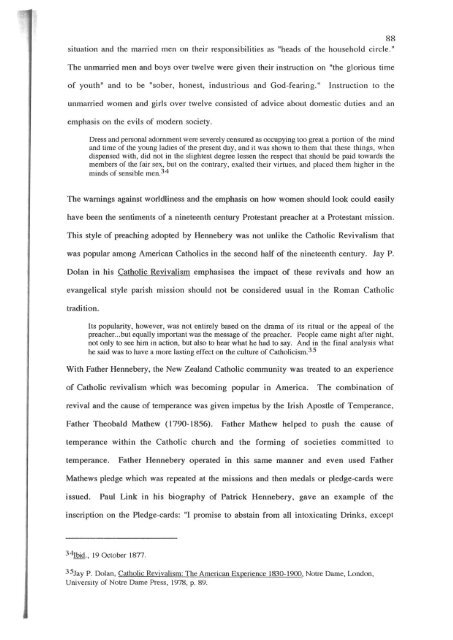TRANSPLANTED IRISH INSTITUTIONS - University of Canterbury
TRANSPLANTED IRISH INSTITUTIONS - University of Canterbury
TRANSPLANTED IRISH INSTITUTIONS - University of Canterbury
You also want an ePaper? Increase the reach of your titles
YUMPU automatically turns print PDFs into web optimized ePapers that Google loves.
88<br />
situation and the married men on their responsibilities as "heads <strong>of</strong> the household circle."<br />
The unmarried men and boys over twelve were given their instruction on "the glorious time<br />
<strong>of</strong> youth" and to be "sober, honest, industrious and God-fearing."<br />
Instruction to the<br />
unmarried women and girls over twelve consisted <strong>of</strong> advice about domestic duties and an<br />
emphasis on the evils <strong>of</strong> modern society.<br />
Dress and personal adornment were severely censured as occupying too great a portion <strong>of</strong> the mind<br />
and time <strong>of</strong> the young ladies <strong>of</strong> the present day, and it was shown to them that these things, when<br />
dispensed with, did not in the slightest degree lessen the respect that should be paid towards the<br />
members <strong>of</strong> the fair sex, but on the contrary, exalted their virtues, and placed them higher in the<br />
minds <strong>of</strong> sensible men. 34<br />
The warnings against worldliness and the emphasis on how women should look could easily<br />
have been the sentiments <strong>of</strong> a nineteenth century Protestant preacher at a Protestant mission.<br />
This style <strong>of</strong> preaching adopted by Hennebery was not unlike the Catholic Revivalism that<br />
was popular among American Catholics in the second half <strong>of</strong> the nineteenth century. Jay P.<br />
Dolan in his Catholic Revivalism emphasises the impact <strong>of</strong> these revivals and how an<br />
evangelical style parish mission should not be considered usual in the Roman Catholic<br />
tradition.<br />
Its popularity, however, was not entirely based on the drama <strong>of</strong> its ritual or the appeal <strong>of</strong> the<br />
preacher... but equally important was the message <strong>of</strong> the preacher. People came night after night,<br />
not only to see him in action, but also to hear what he had to say. And in the final analysis what<br />
he said was to have a more lasting effect on the culture <strong>of</strong> Catholicism. 35<br />
With Father Hennebery, the New Zealand Catholic community was treated to an experience<br />
<strong>of</strong> Catholic revivalism which was becoming popular in America.<br />
The combination <strong>of</strong><br />
revival and the cause <strong>of</strong> temperance was given impetus by the Irish Apostle <strong>of</strong> Temperance,<br />
Father Theobald Mathew (1790- 1856).<br />
Father Mathew helped to push the cause <strong>of</strong><br />
temperance within the Catholic church and the forming <strong>of</strong> societies committed to<br />
temperance.<br />
Father Hennebery operated in this same manner and even used Father<br />
Mathews pledge which was repeated at the missions and then medals or pledge-cards were<br />
issued.<br />
Paul Link in his biography <strong>of</strong> Patrick Hennebery, gave an example <strong>of</strong> the<br />
inscription on the Pledge-cards: "I promise to abstain from all intoxicating Drinks, except<br />
34Ibid., 19 October 1877.<br />
35Jay P. Dolan, Catholic Revivalism: The American Experience 1830-\900, Notre Dame, London,<br />
<strong>University</strong> <strong>of</strong> Notre Dame Press, 1978, p. 89.
















